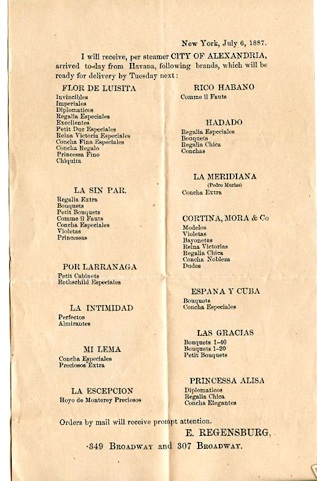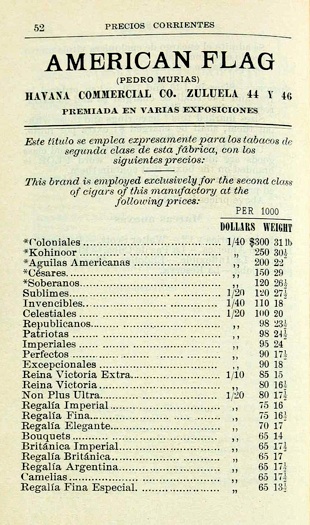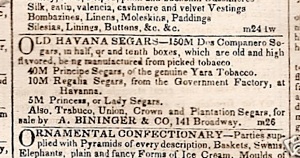All Known Cuban Cigar Brands
An attempt to list as many as possible
A Cigar History Museum Research Project
© Tony Hyman
Last modification June 7, 2011

It’s said that if two Cubans are in a room together they will inevitably find something to argue about. Government and politics are historic favorites, confirmed by the endless series of major and minor revolutions that have been part of that nation for 300 years. Music and baseball are equal sources of debate. And so, I discovered when I visited the island, are historical topics as mundane as when the first cigar band was used, and by whom.
On an island where nearly everyone smokes, cigars and cigarettes are a matter of national pride, debate, and research. The question of who makes the best cigar is a natural argument, and one understandable to competitive North Americans. Less comprehensible to generally history-challenged residents of the U.S. is the Cuban propensity to want to answer questions such as “How many brands of Cuban cigars were there?”
Fifty-plus years of research leads me to believe that, no matter how interesting that question may be to some, it is, and always will be, impossible to answer. But, like other fools before me, I shall give it a try. A difference between me and the various Don Quixotes that have preceded my efforts, is that I promise to make no claims of completeness, only to use all the resources I can to make the results as thorough as possible, the best such list compiled anywhere.
WHAT STARTED THE LIST
This task began with the discovery of a list of pre-nationalization Cuban cigar brands published in Perelman’s Pocket Cyclopedia of Havana Cigars. His original list consists of 1750 brands, and acknowledges that many popular pre-nationalization brands were produced primarily for consumption in Cuba and not for export, and were thus deliberately not listed. Upon reading his list, I noted many well-known export names also missing, among them Tip Top, Rifle, and Para Usted.
I discovered these, and 1,500 others I later identified, were not in Perelman due to the inherent limitations of the sources he used to compile his list. His sources are all worthy publications, just not enough. His list was compiled from:
[1] Ensayo de un Catalogo Universal de Marcas de Cigarros, by Isidro Sureda (Barcelona: I. Sureda, 1951) which is a fine contribution to scholarship but focuses on bands, and the evidence is that more than half the cigars sold weren’t banded.
[2] Registry of Exporting Manufac-turers of the National Commission for Propaganda and Defense of Havana Tobacco. Another good source but it’s merely the Cuban government's official list of manufacturers licensed to export cigars in 1954. One-hundred and fifty years of brands aren’t included, nor are private house brands or cigars created for the domestic Cuban market.
[3] Enzo Infante's excellent history of the pre-nationalization Havana cigar industry, Havana Cigars 1817-1960 (Neptune City, N.J.: T.F.H. Publications, 1997). Like all books, this fine work is limited by what the author knows and / or chooses to share.
Perelman’s greatest omissions are brands from the 1800’s, especially before 1868, not surprising, as information from that critical, tumultuous, period is difficult, and often expensive, to obtain. In his introduction Perelman repeats Infante’s estimate that 800 brands existed by 1859. My research contradicts that number, concluding there were more than 800 companies and that the brands that had come and gone by that date numbered in the multiple thousands. The NCM list adds more than 600 pre-1860 brands to infante’s original list.
Cuban companies tended to be short-lived, a series of quick business-oriented alliances, frequently lasting only a year, two years, three years, and then splitting, re-forming, being bought out, selling out, or disappearing. With the exception of a handful of long-lived manufacturers like Upmann, Bock, Cabañas and Partagas, most brands came and went, as did the companies that made them. Cuban record keeping was originally abysmal, and what records did exist were largely lost in civil war after civil war, and the theft and pillaging of Cuban Government records since cigars were nationalized.
Government registries do not provide all the answers because governments tend to be lazy and inefficient. Even when a government agency is a paragon of virtue and efficiency, they are compiling information from citizens who are often less than forthright. It’s well known that during the entire Spanish era Cubans smuggled every bit as much tobacco and as many cigars as they sold legally.
An attempt to compile a complete list of Cuban brands is complicated by the fact that nearly all Cuban export companies made scores of private label brands for wholesalers, retailers and special events. Some of these were made in quantities of a few hundred boxes or fewer. Records are nonexistent.
HYMAN’S NCM LIST
This Museum list of brands doubles that found in Perelman and other sources. I have been able to add many brands to the list because for 55+ years I have collected THINGS. Things represent what people DO, not what they say they do. I own (and exhibit elsewhere in the Museum) a collection of the actual labels used by pre 1868 Cuban companies on cigars exported to Europe. I also own boxes like La Corona de España made in Cuba under an unregistered brand name or one simply omitted by compilers.
To aid in the compilation of this list, I also turned to catalogs of importers, exporters, wholesalers and retailers from the 19th century which contain prices lists of various brands and vitolas. Pre-WWI trade U.S. and British directories are also an important source of information. Those rare reference books listed scores of otherwise unrecorded companies and brand names. An 1874 Directory was particularly useful as it listed many “annexed” brands (those taken over by other companies). An importer’s 200+ page ledger from 1873 confirmed the existence and importation of many of those brands.
For your information and enjoyment I have color-coded my additions, and, in the case of more recently added names obtained from early ads or catalogs, also added the date of the source.
As you read this list, you will discover instances where minor differences exist between names. Was the brand called J.C. Ruiz or J.C. y Ruiz? Is it Rifle or El Rifle? Zouve or El Zouvo? La Ritica or La Ritoca? La Simpatica or La Simpatia? Or both? Are these translation or recording errors or copy-cat brands? The original list includes four variations of Partagas that probably pertain to the same brand. But maybe not. A great deal of evidence indicates early Cuban makers, like their counterparts in the U.S., were inclined to market cigars under names and designs similar to those of other more successful brands. Ybor’s copycat A Lo Figaro knock-off of the internationally popular Figaro is but one among many examples. In most cases I have chosen to include both versions.
I would like to avoid secondary sources because they create problems. For example, the 1859 list published in the rare Directory of Arts, Commerce, and Industry of Havana was copied in Nancy Stout’s Habanos: the Story of the Havana Cigar, but her version contains a great many obvious spelling, typography and transcription errors, raising question as to how many errors exist that aren’t obvious. Because the source material is so obscure, I am forced to use it (and others), even though readers like myself are unable to ascertain how many of the mistakes are in the originals and how many are the result of sloppy proofreading.
I don’t claim my NCM list is perfect, only that it is more complete than any other list compiled to date, and is as accurate as I, and my sources, can make it.
You will find a few list entries that end in y (Spanish for “and”). To avoid using two lines for a single listing, the words Cia. or Co. meaning “Compania” or “Company” are sometimes omitted.
Additions or corrections to the list are always welcome, especially those from original catalogs and documents. When offering a correction or addition please identify your source,
Tony Hyman


ABOVE: 1887 flyer from a New York cigar manufacturer and wholesaler regarding recently arrived Cuban cigars.
BELOW: 1886 S.S. Pierce catalog. Pierce was a high-end gourmet food, wine and tobacco store in business
for 150+ years (starting in 1831) with 9 outlets in the Boston area.



BELOW: page from a very rare paper-covered 386 page 4.75” x 6.5” anonymously compiled 1901 PRICES CURRENT OF THE HAVANA CIGAR FACTORIES published annually. This rare guide prices more than 130 brands and more than 10,000 sizes and shapes along with details about bands, foil, glass tubes, box sizes, etc.
Prices are quoted in Spanish gold.
1838 reference to specific brands in a NYC newspaper, typical of pre 1860 ads I buy for the information.

